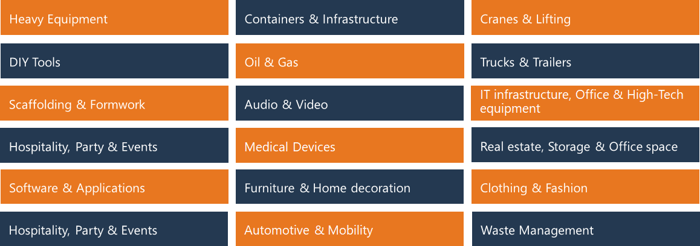Do One-Size-Fits-All Equipment Rental Software Exist?
 Michiel Toppers
Michiel Toppers
Table of contents
Let me start with a give-away. “One-size-fits-all” equipment rental software does not exist. As an equipment rental company, the kind of rental software you will need depends on a lot of factors, such as your industry.
In practice, equipment rental software for automotive rental (e.g., cars, trucks, and vans) usually has different strengths and weaknesses than software intended for construction equipment rental (e.g., cranes, excavators, and dump trucks).
Software for scaffolding and/or formwork rental requires different in-depth functionality than storage space or real-estate rental. Critical functionalities within the rental of cooling solutions & containers industry are again different than those within the DIY tool rental industry.

However, in the end, the focus areas, high-level processes, and the associated basic requirements are all the same for every equipment rental company (this also includes equipment leasing companies, which define leasing as long-term (> 1 year) rental).
In this blog, I will explain why one-size-fits-all does not apply to an equipment rental software solution. You will also learn how DynaRent Solutions Suite, our rental software, can support your equipment rental & lease operations.
How does the need for equipment rental software vary for different companies?
The needs of one equipment rental company differ from another based on a lot of factors. However, there are a few processes that are common for all companies across industries.
Here are the main processes that are commonly seen across all equipment rental companies:
- Equipment procurement or purchase (sometimes even produce)
- Equipment rent-out
- Equipment service, maintain, and repair
- Equipment returning
- Billing, invoicing & crediting
- Equipment selling
- Monitoring & reporting
The main difference in rental software requirements lies in the specific details of these common processes and how they are performed within a specific industry—or sometimes even within one particular company within that industry.
For instance, the pre-rental and post-rental activities (e.g., planning & dispatching, inspections & services, transportation, and (dis)assembly) are critical within heavy construction equipment rental companies. Managing these activities in the most efficient and effective way has a great impact on the bottom-line of such companies. And, when done properly, it even enables them to thrive in their respective industries.
On the other hand, for a DIY tool (often B2C) rental company, these pre- and post-rental activities are almost non-existent and, therefore, trivial as a requirement (i.e., planning & dispatching and transportation). These types of companies will rather focus on the speed and flexibility in which an “off-the-counter” transaction can be performed most efficiently and effectively.
How to find an equipment rental software that fulfills most of your needs?
As mentioned earlier, there is no one best solution for every equipment rental company out there. However, there is always some best solution per rental company type. This might still be too generic for your specific equipment rental business needs. Nevertheless, it allows you to initially separate the so-called wheat from the chaff and short-list the most suitable equipment rental software solutions for your business.
Let’s take a look at the 17 main industries in which equipment rental is a common business model:

At STAEDEAN, we have worked with all of the above industries in the past 20 years. Having had the privilege to learn from their challenges, processes, and business concepts, we created DynaRent Solutions Suite, a comprehensive equipment rental software solution.
Example scenarios where one equipment rental software helps meet different needs
We have come across many cases at STAEDEAN where one equipment rental company deals with different equipment (of the same kind) or different industries. These companies were able to optimally use our DynaRent Solutions Suite to meet their various equipment rental needs.
Here are a few scenarios we’ve seen at STAEDEAN:
Scenario 1
A lot of the different industries perform the same type of processes, granularly, on the same kind of equipment. For example, when renting out Mobile Elevating Work Platforms (MEWPs), the companies deal with similar challenges as when they rent out excavators or forklift trucks. The processes to effectively deal with these challenges are also pretty much alike, although the rental industries are different.
Scenario 2
What we also see a lot, especially with the larger equipment rental companies, which offer complete equipment rental solutions to their clients, is that the same company can be active in multiple rental industries at once. Thus, they provide different types of equipment and have different processes to deal with the industry-specific challenges they face.
One customer can offer cranes and lifting equipment services, in combination with MEWPs and/or deep-loader trucks for transportation purposes. These different types of equipment can be rented separately. However, such companies also use their fleet as supportive equipment in a total equipment rental offering solution towards their clients.
Scenario 3
We have seen companies that rent out to external business customers (B2B), internal business customers (Inter-company B2B), and those that rent out to private customers (B2C).
The most important differences between these industries come down to the following topics:
1. Project-driven vs. order-driven equipment rental companies
A. Project-driven companies
These companies treat every rental deal as a sub-project.
Sometimes this is an actual (physical) project (e.g., site construction for a new office building) for which several pieces of equipment, ancillaries, and/or personnel are allocated. At other times, a project’s way of working (in terms of planning, dispatching, and the execution of tasks) is what defines this project-driven characteristic.
Multiple rental orders can be linked to the same project.
Construction & infrastructure, automotive & mobility, on-shore & offshore (oil & gas), scaffolding &framework, Audio & video are a few common equipment rental industries that usually operate in a project-driven way.
B. Order-driven companiesCompanies driven by orders treat every rental order as a “new beginning”. Each order is their “project” (so to say), and everything revolves around that rental order. It starts with the on-rent date and ends with the off-rent date.
The rental orders are stand-alone entities that can be linked to a physical project (which we call work location). However, they are generally not connected to an administrative project, as described above for project-driven companies.
Common equipment rental industries that usually operate in an order-driven way include heavy equipment, automotive & mobility, DIY tools, trucks & trailers, real estate, storage & office space, among others.
2. Serialized equipment, non-serialized equipment (bulk), or serialized-bulk equipment:
Serialized equipment
These are the kind of equipment that are uniquely identifiable (e.g., serial number, fleet number, asset number). Commonly, they have the financial value to be treated and processed as such.
Non-serialized equipment
This equipment type is not uniquely identifiable and can, therefore, only be considered in quantities. Commonly, the financial value of this equipment categorization is relatively low and does not justify it to be treated and processed as serialized equipment.
Serialized bulk
These have nothing to do with the type of equipment but rather with the way a company wants to treat or process this equipment category. In other words, the equipment might be serialized. Still, due to the large quantities and intrinsic handling costs involved, the company would want to treat them as bulk (non-serialized) equipment in most of their processes, such as order line creation, order picking, and rental returns.
3. Solo equipment, manned equipment, or total solution
Solo equipment rental: is characterized by only renting out the equipment itself, without providing an operator. It usually includes no, or very few, accompanying services and/or ancillaries.
Manned equipment rental: is characterized by renting out the equipment together with an operator (e.g. crane driver, truck driver) or sometimes even with additional supportive personnel (e.g. foreman). Most of the time this involves heavier equipment which requires highly specialized personnel to (un-)install, (dis-)assemble and/or operate the equipment.
Equipment rental companies offering total solutions: usually deal with both solo and manned equipment. They combine the equipment types to offer a total solution to a customer request.
4. Inter-company, cross-country and shared rental fleet
Within larger equipment rental companies, or those that are operating in larger countries, the optimization of efficient and effective rental fleet management is a common struggle. And, here are some of the most common challenges seen within such companies:
Allocations of revenue and costs
Equipment is either financially owned by one financial, legal entity (a so-called fixed asset company) within a group of companies (holding company) or distributed among multiple operational, legal entities. This, practically, means that every subsidiary (within the holding) financially owns a sub-set of the full rental fleet of the holding.
Availability, logistics, and planning
Besides the allocations, sharing equipment also challenges the organization in areas like equipment & resource availability, logistics (including transportation), and planning.
Efficiently and effectively managing a shared pool of equipment requires an in-depth, coherent, timely & over-time insight into equipment and resource availability on a global scale.
In all rental companies, evaluation of equipment availability needs to be done over 4 different rental equipment markers: transactions, technical condition, location, and specifications.
Compliance
Finally, sharing equipment also challenges the company in being compliant with local, regional, and/or country-specific regulations. Below are some vivid examples of challenges that, in our experience, are those that cross-border equipment rental companies face.
When using equipment in a cross-country/border context, complying with equipment safety and health regulations in one country does not automatically apply to another country as well.
When crossing the border with rental equipment, a customs invoice is necessary to prove that it is not sold to the receiving customer in the other country. Therefore, you avoid paying high equipment import taxes, which would apply when selling and importing equipment into that country.
Looking at the transportation of equipment, the rules and regulations concerning, e.g., allowed driving times, maximum loads, emission levels, and/or designated routes for trucks can also differ per country.
5. Short-term rental, long-term rental, and leasing
Short-term rental, in our definition, refers to the equipment that is reserved for a client’s operational usage for a certain duration. This usually implies that the equipment is supporting a single job that the client must perform.
Long-term rental, in our definition, refers to the equipment whose operational ownership is transferred to a client for a given duration. This usually implies that the equipment is supporting multiple jobs that the client must perform.
Leasing, in our definition, is when the client obtains the operational ownership of the equipment for the duration of leas, which is usually longer than one month. The duration is always pre-set (i.e., fixed to a 4-year contract) and will never be an open-ended contract.
Finding the right equipment rental software solution
Clearly, you can see that it is all a matter of figuring out what your needs are as an equipment rental company. You can consider the following 8 ERP essentials of an equipment rental software solution.
Once you have your definite list of requirements, start exploring equipment rental solutions that best fit in. Select the one that can meet most, if not all, of your business needs. A comprehensive solution such as our DynaRent Solutions Suite can help you manage your unique rental operations and streamline your business.
